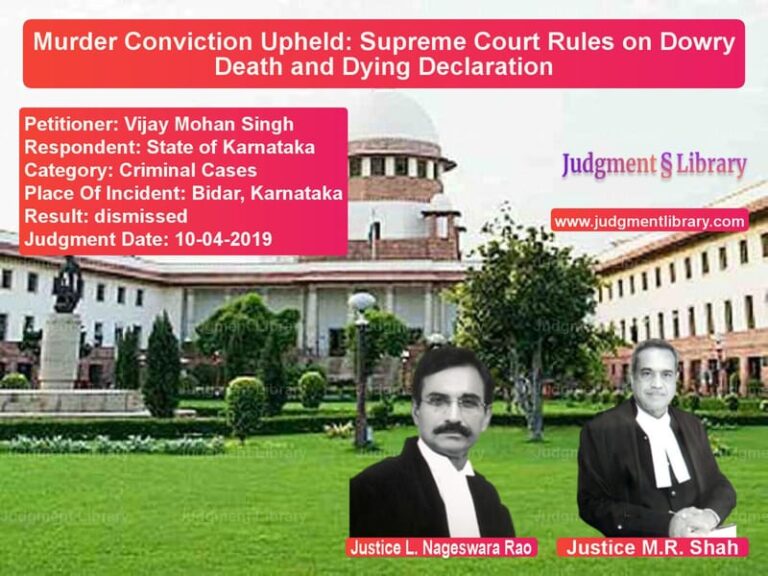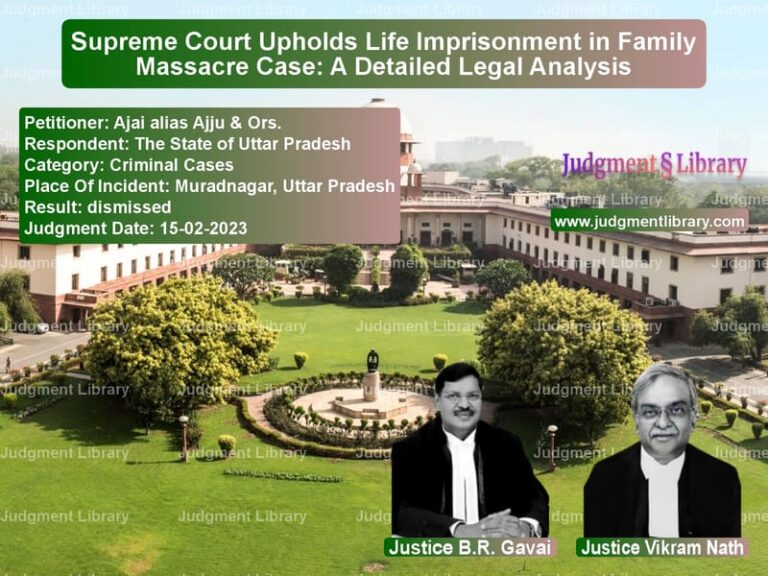Stamp Duty on Court-Monitored Auctions: Supreme Court’s Landmark Judgment Explained
The Supreme Court of India recently delivered a crucial judgment clarifying the application of Section 47A of the Indian Stamp Act concerning stamp duty on properties sold through court-monitored auctions. This case arose from disputes where the Registrar of Assurances demanded higher stamp duties based on market assessments rather than the transaction value determined through judicial auctions. The verdict carries significant implications for property buyers, auction processes, and state revenue authorities.
Background of the Case
The dispute stemmed from two separate cases consolidated for consideration:
- A partition suit involving Sati Pvt. Ltd., where a property in Kolkata was auctioned under the supervision of a court-appointed receiver.
- A liquidation proceeding where ASL Vyapar Pvt. Ltd. purchased the assets of a wound-up company.
In both instances, the properties were sold transparently through public auctions. The buyers paid stamp duty based on the transaction price determined through the judicial process. However, the Registrar of Assurances, invoking Section 47A of the Indian Stamp Act, issued notices requiring the buyers to pay additional stamp duties based on its assessment of the properties’ market value.
Legal Issue Before the Supreme Court
The primary question before the Court was whether the Registering Authority could reassess the market value of a property sold through a court auction and demand additional stamp duty. The appellants (ASL Vyapar Pvt. Ltd. & Sati Pvt. Ltd.) contended that court-ordered auctions inherently determined the market value, whereas the respondents (Registrar of Assurances & Anr.) argued that distress sales often fetch lower prices, necessitating reassessment.
Petitioners’ Arguments
The petitioners argued that once a court supervises a property sale and determines its value, the registering authority has no right to reassess its market value. They relied on the following judicial precedents:
- V.N. Devadoss v. Chief Revenue Control Office: The Supreme Court ruled that stamp duty should be based on transaction value unless there was evidence of intentional undervaluation.
- Govt. of Andhra Pradesh v. P. Laxmi Devi: The Court acknowledged the need to prevent fraudulent undervaluation but clarified that public auctions represented fair market value.
They contended that Section 47A was intended to prevent manipulation in private transactions and should not apply to judicial auctions.
Respondents’ Arguments
The Registrar of Assurances & Anr. defended their decision to reassess market value, arguing:
- Section 47A of the Indian Stamp Act empowers authorities to ensure that properties are not undervalued to evade stamp duty.
- Courts cannot preemptively fix stamp duty values, as the law mandates independent assessment by the Registering Authority.
- Distress sales or forced auctions often result in lower prices; therefore, reassessment is necessary to reflect actual market conditions.
Supreme Court’s Verdict
The three-judge bench, consisting of Justices Sanjay Kishan Kaul, Abhay S. Oka, and Vikram Nath, ruled in favor of the petitioners. Key findings included:
- Court-monitored auctions should be treated as open-market sales.
- The highest bid obtained in a public auction represents the actual market value.
- Once a court confirms a sale, the Registering Authority cannot reassess the property’s value.
The judgment emphasized that Section 47A was designed to prevent undervaluation in private sales, not to question transparent court-supervised transactions.
Judicial Reasoning and Observations
The Court analyzed various legal principles and precedents to arrive at its decision:
- Open Market Sale Concept: The Court held that a judicial auction with wide publicity, independent bidders, and competitive bidding met the definition of an open market sale. Consequently, any attempt by the Registrar to reassess the price contradicted the fundamental nature of such a transaction.
- Protection Against Arbitrary Reassessment: The Court underscored that allowing authorities to arbitrarily question court-approved transactions would create legal uncertainty and deter genuine buyers from participating in judicial auctions.
- Revenue Considerations: While the state’s objective of maximizing revenue through proper stamp duty collection was acknowledged, the Court stated that artificially inflating market values beyond the bid price defeated the purpose of fair and transparent auctions.
- Sanctity of Court Proceedings: A judicial sale carries legal sanctity, and the Registering Authority cannot sit in appeal over the Court’s valuation.
Implications of the Judgment
This ruling has significant implications for various stakeholders:
- Property Buyers: Buyers participating in judicial auctions now have greater legal certainty that they will not face arbitrary reassessment of stamp duty.
- Judicial Auction Processes: The decision reinforces the credibility of court-monitored auctions as legitimate indicators of market value.
- Revenue Authorities: While preventing fraud remains a priority, revenue officials cannot use market reassessment to override court-approved transactions.
Conclusion
The Supreme Court’s decision provides much-needed clarity on how stamp duty should be assessed for properties sold through court-monitored auctions. By reinforcing the principle that judicial auctions represent the true market value, the Court has safeguarded both buyers’ interests and the integrity of judicial sales. This ruling ensures that transparent auction processes are not subject to arbitrary interference, promoting fairer and more predictable legal outcomes in property transactions.
Petitioner Name: ASL Vyapar Private Ltd. & Sati Pvt. Ltd..Respondent Name: Registrar of Assurances & Anr..Judgment By: Justice Sanjay Kishan Kaul, Justice Abhay S. Oka, Justice Vikram Nath.Place Of Incident: Kolkata, West Bengal.Judgment Date: 10-11-2022.
Don’t miss out on the full details! Download the complete judgment in PDF format below and gain valuable insights instantly!
Download Judgment: asl-vyapar-private-l-vs-registrar-of-assuran-supreme-court-of-india-judgment-dated-10-11-2022.pdf
Directly Download Judgment: Directly download this Judgment
See all petitions in Arbitration Awards
See all petitions in Dispute Resolution Mechanisms
See all petitions in Enforcement of Awards
See all petitions in Judgment by Sanjay Kishan Kaul
See all petitions in Judgment by Abhay S. Oka
See all petitions in Judgment by Vikram Nath
See all petitions in dismissed
See all petitions in supreme court of India judgments November 2022
See all petitions in 2022 judgments
See all posts in Arbitration and Alternate Dispute Resolution Category
See all allowed petitions in Arbitration and Alternate Dispute Resolution Category
See all Dismissed petitions in Arbitration and Alternate Dispute Resolution Category
See all partially allowed petitions in Arbitration and Alternate Dispute Resolution Category







